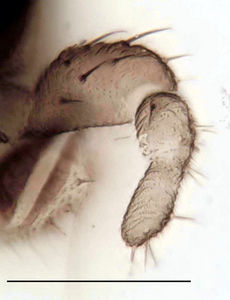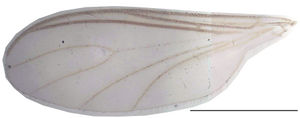Trichosiopsis viatica
Ordo: Diptera
Familia: Sciaridae
Genus: Trichosiopsis
Name
Trichosiopsis viatica (Winnertz, 1867) – Wikispecies link – ZooBank link
- Sciara viatica Winnertz, 1867[1]: 130-131
- Trichosia (Leptosciarella) viatica (Winnertz, 1867)[2]: 23
- Leptosciarella (Leptosciarella) viatica (Winnertz, 1867)[3]: 75-77, fig. 24
- Sciara proxima Winnertz, 1867[1]: 33
Type material
Lectotype: ♀, no. 3029 and 627 in SMFD, bred from rotten wood, leg. v. Heyden
Type locality
Germany, Frankfurt/Main
Material studied
Germany: 3 ♂, Baden-Württemberg, Malsch, poplar forest, Malaise trap, Doczkal, 17.3.-14.04.2003, PKHH 4793, PASS 70, PDDM 90; 10 ♂, Malsch, forest NE “Kieswerk Glaser”, clearing, beech stump, Malaise trap, Doczkal, 19.3.-21.04.2010, PKHH 7887-7896; 1 ♂, Bavaria, Nature Reserve Schluifelder Moos, fen, Schacht, 27.03.1989, ZSMC 14; 1 ♂, Brandenburg, Britz near Eberswalde, Sommer, 20.04.1993, PWMP 1736; 1 ♂, 22.04.1993, PWMP 1735; 2 ♂, Luisenfelde near Eberswalde, langer Berg, Sommer, 08.04.1993, PWMP 1734; 1 ♂, Traubendorfer Grenzlauch, Malaise trap, Mohrig, 20.04.2000, PWMP 1610; 2 ♂, Lower Saxony, Göttingen, Hövemeyer, 09.07.1986, PWMP 1730; 1 ♂, Hesse, Sinntal, mixed grass and wood land, sweep netting, Kappert, 03.04.2012; 1 ♂, Mecklenburg-Vorpommern, Rosenthal near Strasburg, beech forest, sweep netting, Jaschhof, 23.04.1994, PKHH 5318; 1 ♂, North-Rhine-Westphalia, Köln-Poll, garden, Malaise trap, Franzen, 29.1.-26.02.2002, ZSMC 2054; 1 ♂, 12.-19.03.2002, ZSMC 2004; 2 ♂, Rhineland-Palatinate, Kirchheimbolanden, Nature Reserve Albertskreuz, Malaise trap, Doczkal, 11.4.-02.05.2002, PKHH 5168, 5169; 1 ♂ 1 ♀, Schleswig-Holstein, Blumenthal, wood sample alder, elder, hazel, photoeclector, Arp, 10.4.-19.05.2000, PKHH 3139; 1 ♂, wood sample, alder, photoeclector, Arp, PKHH 3192; 1 ♂, Flensburg, “Marienhölzung”, forest, Malaise trap, Barkemeyer, 11.-18.04.1997, PKHH 2907; 1 ♂, Kiel, University, garden, Malaise trap, Heller, 23.-30.03.1995, PKHH 967; 5 ♂, Siggen, beech and oak forest, photoeclector, Tischler, 18.5.-01.06.1987, PKHH 541-545; 1 ♂, Trappenkamp, spruce forest, sweep netting, Heller, 01.05.1996, PKHH 1375; 1 ♂, Wankendorf, old beechstump, photoeclector, Warning, 14.-28.03.1988, PKHH 20; 2 ♂, alder, old rotten wod, photoeclector, Warning, 28.3.-10.04.1989, PWMP 1731; 1 ♂, Erle, Stubben alt, photoeclector, Warning, PKHH 585; Greece: 2 ♂, Procom, riverine forest along river Strymon; Populus alba, Juglans regia and Corylus avellana, Malaise trap, Ramel, 10.-16.03.2008, PKHH 7010; Luxembourg: 1 ♂, Niederwampach, Tussen-Tunnel 1, Weber, 08.04.2007, PKHH 5685; Netherlands: 1 ♂ 1 ♀, Udenhout, Nature Reserve 'De Brand', Malaise trap, v. Zuijlen, 17.-25.03.1990, PWMP 1733; 5 ♂, 29.9.-06.10.1990, PWMP 1728, 1729, 1732; Sweden: 1 ♂, Bohuslän, Ödsmal, Hällsberget, broad leaved deciduous forest, Malaise trap, Swedish Malaise Trap, 24.4.-25.05.2004, NHRS 3005; 19 ♂, Skåne, Mölle, Kullabergs naturreservat, Oak forest in southern slope, Malaise trap, Swedish Malaise Trap Project, 31.10.-04.05.2006, NHRS 1110; 7 ♂, Simrishamn, Stenshuvud National Park: Svabeholmsskog, hornbeam forest, Malaise trap, Swedish Malaise Trap Project, 22.5.-20.06.2005, PKHH 7239; 6 ♂, Småland, Alsterbro, Kalmar län, Mixed forest, Malaise trap, Swedish Malaise Trap Project , 30.4.-05.05.2005, PKHH 6682, 6833; NHRS 2872, 2885; PASS 201; ZMSC 2460; 1 ♂, Bäckebo, Grytsjöns naurreservat, Old aspen forest in boulder terrain, Malaise trap, Swedish Malaise Trap Project, 21.4.-18.05.2006, PKHH 7311; 3 ♂, Grytsjöns naurreservat, Old moisty haymaking meadow in forest edge, Malaise trap, Swedish Malaise Trap Project, PKHH 7323; 1 ♂, Södermannland, Nämdö, Krokudden, Krokvik, spruce and pine forest, Malaise trap, Williams & Malm, 10.4.-23.05.2009, NHRS 4718; 1 ♂, NHRS 4725; 5 ♂, Uppland, Stockholm, Stockholm län, Djurgården Park, Malaise trap, Heinakroon, 4.-16.05.1994, NHRS 372, 375, 386-388.
Description (male)
Head. Eye bridge 4–6 rows of facets. LW-index of 4th antennal flagellar segment 2.15–2.5; neck 0.25–0.35 of segment width; Transition of basal part to neck pronounced. Colour of neck unicolour. Antennal hairs shorter than segment width; dense; salient. Palps darkened; short; palpomeres 3. First palpomere thickened; with 3–8 bristles; with only some sparse sensillae. Second palpomere shortly oval. Third palpomere as long as first segment. Thorax. Colour brown. Notum unicolorous. Thoracic setae normal; darkened. Mesonotum with some weaker central bristles. Posterior pronotum setose. Postpronotal setae 1–4. Laterotergite bare. Legs. Colour yellow. Hind coxae of same colour as femora, or darkened. Hairs on fore coxae bright. Front tibia apically with a patch of setae. Front tibial organ bright. Front tibial organ not bordered. Tibial setae on hind legs weak, inconspicuous. Tibial spurs of equal length. Claws untoothed. Wings. Wings slightly darkened; reduced, with weakly developed anal lobe. Wing membrane without macrotrichia. Wing venation weak, with faint m-base. M-fork of normal shape. R1 inserting at or slightly before base of m-fork, or inserting clearly before base of m-fork; posterior veins with macrotrichia; stM with a few macrotrichia; cuA1 and cuA2 mainly with macrotrichia; bM bare; r-m bare, or with a few setae; bM:r-M 1.3–1.7; st-Cu:bM 0.6–0.8; r1:r 1.1–1.55; C:w 0.6–0.75. Halteres bright; of normal length. Abdomen. Abdominal setae dorsally dark; ventrally of different colour. Hypopygium concolour with abdomen; 0.5–0.7 × longer than wide. Base of gonocoxites with normal, weak hairs; gonocoxites narrowly separated; inner margin of gonocoxites normally U-shaped; inner part of hypopygium scarcely setose; elongated setae on valves of hypopygium absent. Gonostylus globular; 1.7–2.1 × longer than wide; Inner margin concave; apex equally rounded. Apical tooth present; 2.2–3 × longer than broad; normal. Awl-like setae normal; below apex present. Megasetae on inner part of gonostylus absent. Whiplash-hair absent. Tegmen 0.55–0.75 × longer than broad; rectangular with rounded edges; normal; Central process absent. Length of aedeagus/hypopygium 16–26 %; Aeadeagal apical structure absent. Measurements. Body size 2.8–3.5 mm. Hind tibia 1.3–1.55 mm. Wing length 2.4–3.2 mm.
Diagnosis
Trichosiopsis viatica is a small, bright species of and peculiar by the bright halteres and the darkened wing veins. The palpi are shortened and have numerous bristles on the first segment. The similar species Leptosciarella dimera has a less thickened first palp segment, much longer antennae, and dark front coxal hairs. The shape of the gonostylus is also similar in Leptosciarella subviatica, which has stronger setae, dark halteres and a completely setose y-vein.
DNA Barcoding
The COI sequence is assigned to BIN BOLD:ACF8144 (average distance 0.02%, max. 0.32%, n=50, K2P: 9.52%).
Etymology
viaticus lat. = travelling.
Ecology
The type specimen of Trichosiopsis viatica was bred from old rotten wood and this seems to be the normal habitat of the larvae, because many of the recorded specimens have been bred from wood, often in large quantities. The adults occur quite early in the year, already in March and April and are rarely found after May. The distribution seems to be mainly restricted to the temperate forest region of Europe. However, there are a few records from Canada, which indicate, that Tr. viatica has a Holarctic distribution.
Discussion
Tr. viatica is the name giving species of the “viatica-type” (Mohrig & Menzel. 1997[3]: 50), having dorsally rounded gonostyli. This is probably not a natural group and needs to be revisited, because the genetically nearest neighbour of Tr. viatica appears to be Trichosiopsis scutellata.
Distribution
Austria[3], Bulgaria[4], Norway[5], Czech Republic[6], Finland[2], Germany[1][7][3][8][9][10][11], Great Britain[12][3][13], Greece, Ireland[14][13], Luxembourg[15], Netherlands[16], Norway[5], Poland[3], Romania[17], Sweden[18], Switzerland[19]
Images
|
References
- ↑ 1.0 1.1 1.2 Winnertz, J. 1867: Beitrag zu einer Monographie der Sciarinen. W. Braunmüller, Wien. BHL
- ↑ 2.0 2.1 Tuomikoski, R. 1960: Zur Kenntnis der Sciariden (Dipt.) Finnlands. Annales Zoologici Societatis Zoologicae Botanicae Fennicae “Vanamo”, 21, 1–164.
- ↑ 3.0 3.1 3.2 3.3 3.4 3.5 Mohrig, W.; Menzel, F. 1997: Revision der paläarktischen Arten von Trichosia Winnertz sensu Tuomikoski, 1960 (Diptera, Sciaridae). – Teil II. Gattungen Leptosciarella Tuomikoski, 1960 und Trichodapus gen. nov. Studia dipterologica, 4(1), 41–98.
- ↑ Dimitrova, B.; Mohrig, W. 1993: Beitrag zur Trauermückenfauna Bulgariens (Diptera, Sciaridae). II. Acta Zoologica Bulgarica, 46, 89–96.
- ↑ 5.0 5.1 GBIF Trichosiopsis viatica
- ↑ Rudzinski, H.-G. 2000: Neue Trauermücken aus Mähren (Diptera: Sciaridae). Mitteilungen des Internationalen Entomologischen Vereins e. V., 25, 75–86.
- ↑ Rudzinski, H.-G. 1994: Fundort Schöngeising - die Trauermücken mit einer Liste aller bisher in Bayern aktuell nachgewiesenen Arten (vorläufig als“ Zweiflügler aus Bayern IV”) (Diptera Nematocera, Sciaridae). Entomofauna, 15(25), 293–311. PDF
- ↑ Heller, K. 1999: Trauermücken (Diptera: Sciaridae) von Gönnersdorf (Kr. Daun). Beiträge zur Insektenfauna der Eifeldorfer 20. Dendrocopos, 26, 249-262.
- ↑ Heller, K. 2002: Beiträge zur Sciaridenfauna Schleswig-Holsteins (Diptera, Sciaridae). Teil III. Die Sciariden des Projektgebietes “Integrierter Landbau Rade.” Dipteron, 4, 109-124.
- ↑ Hövemeyer, K. 1997: Die Dipterengemeinschaft eines südniedersächsischen Eichen-Hainbuchenwaldes. Göttinger Naturkundliche Schriften, 4, 137–150.
- ↑ Hövemeyer, K. 1998: Diptera associated with dead beech wood. Studia dipterologica, 5(1), 113–122.
- ↑ Freeman, P. 1983: Sciarid flies. Diptera, Sciaridae. Handbooks for the Identification of British Insects. Vol 9 (6). Royal Entomological Society of London, London.
- ↑ 13.0 13.1 Menzel, F.; Smith, J.E.; Chandler, P. 2006: The sciarid fauna of the British Isles (Diptera: Sciaridae), including descriptions of six new species. Zoological Journal of the Linnean Society, 146, 1-147. PDF
- ↑ Menzel, F.; Smith, J.E.; Chandler, P. 2006: The sciarid fauna of the British Isles (Diptera: Sciaridae), including descriptions of six new species. Zoological Journal of the Linnean Society, 146, 1–147.
- ↑ Heller, K.; Weber, D. 2013: Trauermücken (Diptera, Sciaridae) aus Höhlen des Großherzogtums Luxemburg. Ferrantia, 39, 320–336.
- ↑ Mohrig, W. 1996: Sciaridae (Rowmuggen). In: J. W. A. van Zuijlen, T. M. J. Peeters, P. S. van Wielink, A. P. W. van Eck, et al. (Eds.), Brand-Stof. Een inventarisatie van der entomofauna van het Natuurreservaat “De Brand” in 1990. Insektenwerkgroep KNNV-afdeling, Tilburg. pp. 97–98.
- ↑ Hondru, N. 1965: Specii noi de Sciaride (Diptera - Sciaridae) din R. P. R. Studii si cercetari de biologie (Seria Zoologie), 17(3), 211–215.
- ↑ Heller, K.; Vilkamaa, P.; Hippa, H. 2009: An annotated check list of Swedish black fungus gnats (Diptera, Sciaridae). Sahlbergia, 15(1), 23-51.
- ↑ Schiegg, K.; Obrist, M.; Duelli, P.; Merz, B. et al. 1999: Diptera and Coleoptera collected in the Forest Reserve Sihlwald ZH. Mitteilungen der Schweizerischen Entomologischen Gesellschaft, 72, 289–302.








